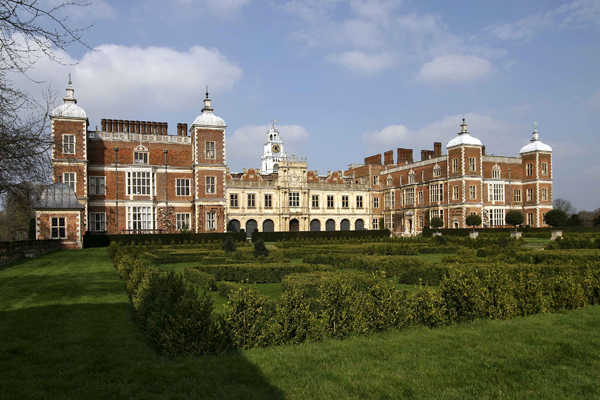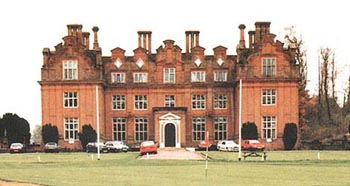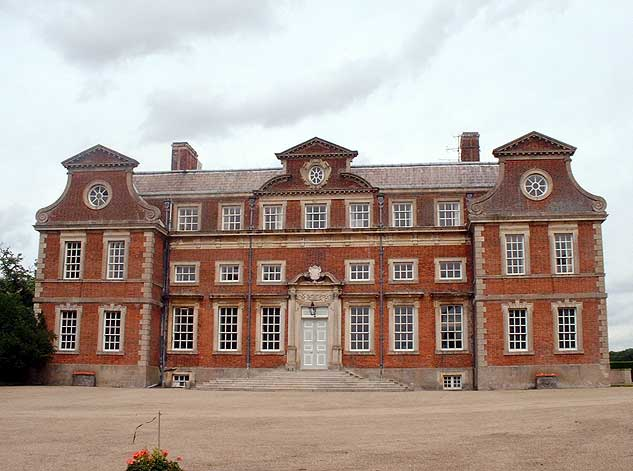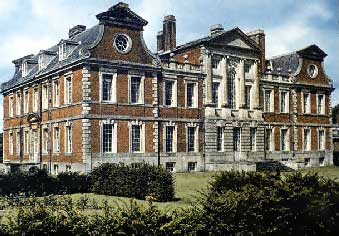Inigo Jones – Part 4 – Reception and Influence
Jacobean architecture is demonstrated by Hatfield House (see
About Britain Hatfield House) , owned by Robert Cecil, son of Lord Burleigh, built 1607-12. He never actually slept in the house as he died as it was being finished. The mason
was Simon Basil and the carpenter Robert Limming and it is thought they
collaborated on the design with Cecil who had an extensive library.
The entrance leads into a screens passage and you then turn into an
asymmetrical hall two storeys high (this is also the plan at Hampton Court).
The stone loggia of the building might be by Inigo Jones as a payment was
made to him but it may have been for a masque. It has elements of Jones.
Blickling Hall (National Trust, built 1616-1627) is very similar. Note the
shaped gables (also called Dutch or semi-classical gables) that are common to
both. They are the leitmotif for Jacobean architecture. The Hatfield clock tower
is 19th century but Blickling may be original. The chimneys are original. Robert
Limming also worked on Blickling and this can help spread a design across the
country.
The Banqueting House was built at the same time as Blickling.
Charlton House, Greenwich, 1607-12, Adam Newton, Prince Henry’s tutor, built
the house in Greenwich to be close to the court. It shows the typical H-shaped
plan which is the common Jacobean ground plan compared to the Tudor court yard.
See the John Thorpe drawings of the ground and first floors based on a design
for Sir John Danvers house in Chelsea 1622 described by Samuel Pepys as one of
the prettiest houses he had ever seen. He travelled extensively in France and
Italy and collected art. The hall is at the bottom front with stairs at the
side. Stairs in the middle of the hall are very unusual (although a raised dais
is common in early Tudor halls). The front overlooks the Thames and the garden
at the back is extensive and famous in gardening history.
The drawing is not accurate but we don’t know if he drew from the house or
architectural drawings. When drawings and house survive there are often major
differences with the work of John Thorpe. It is published in the Walpole Society
Journal in the Warburg Library.
1631 “Dutch House” at Kew (in gardens)
Swakeleys, Ickenham, Greater London (1629-1638):
Built for the Lord Mayor, in commuting distance of London. (New windows).
Bigger and broader. Compare Charlton the the Dutch House.
Dutch House
- Square and compact
- Prominent shaped gables
- (not original windows)
- Steep pitched roof
- No quoins
- No elaborated strapwork porch
- No towers
Why is it simpler?
See Wooton (in the handout) – “ordinary stone”, “ravishes the beholder”. He
was very sophisticated and well travelled but he represents a fundamental
change. The interiors can be very elaborate even when the outside is plain.
“Artisan Mannerism” is the term used in architectural works, also the Artisan
Style. For the period 1530-1830. Subordinate style used by John Harris. It tends
to mean any design not done by Jones and it is slightly condescending.
Broome Park, 1635-38, brick, shaped gables, hipped roof. Many such buildings.
As not in the Inigo Jones style they are called Artisan Mannerist.
Where did the gables come from? In sections or compartments we assume it is
from Jones!
1617, Fulke Greville House, Jones. Originally from Italy or Germany? Compare
with Lord Maltravers House 1630s, very advanced.
Bolsover Riding School, 1635-40, English Heritage, Derbyshire, Cavendish by
John Smithson, son Robert Smithson. Shaped gables. We know he went to London and
we know he would have seen the latest fashion including 1619 the front of the
Bathe House, Sir Fulke Greville in Holborn (by Jones, now lost). It has a
balcony (called a pergola in England).
The John Smithson and Jones drawings are very different. Could he have drawn
it from memory? (1618-19 in London).
Houses Lady Cork and another for Colonel Cecil, 1619, another shaped gable
and pergola.
Arundel House, London gateway by Inigo Jones. Jones introduced pergolas to
London.
Jones design for Colonel Cecil’s gateway – balance, harmony, aesthetics,
Smithson has proportions wrong and the details wrong.
Arundel Gate Smithson v. Jones design. The John Smithson is ugly.
Did Caversham family pay for Smithson’s travels to London to get up-to-date?
 Little Castle at Bolsover, 1612-14, John Smithson, crenellated, fake medieval
Little Castle at Bolsover, 1612-14, John Smithson, crenellated, fake medieval
castle, revival of chivalry, built before London visit but changed after visit
(dressing as knights, dressing in armour, return to chivalry in James I reign.)
Copied from Jones at Arundel Castle but this is a garden gate with
rustication that has been moved to a piano mobile! Jones would have been
appalled.
First storey (basement) of the new Banqueting House, John SMithson, that was
all there was in 1618-9. Has a door! Was it blocked up during the building or a
few years after (like apse.)
Note voissoir windows, these were new at the time.
Raynham Hall, 1621-35, Norfolk (back)
Raynham Hall front. It was thought to be by Jones (!) but an article in 1980
suggests the design was by Sir Roger Townsend’s own design. We know he visited
the Banqueting House when it was being constructed. It is a H-plan house, screen
passage turning into a great hall. The house is a mish-mash of styles, early and
late.
Nicholas Stone worked alongside Jones. Francis Holles, 1622, by Stone in
Westminster Abbey. Swag on statue is from the Banqueting House. Stone worked on
the Banqueting House. The figure is modelled on Michelangelo’s Medici tomb. He
also designed buildings (see handout). Yeux d’boeuf (bull’s eye) windows. See
handout (3) – Jones had a hand. See handout (4) Isaac de Caus (son of de Caus).
Kirby Hall, Elizabethan remodelled 1638-40 by Nicholas Stone (we don’t know
if Jones advised.)
Isaac de Caus Serlian design, yeux de boeuf windows on left (see handout).
Design for Wilton. Compare with Jones’s remodelled design for St. Paul’s, 1633.
Master masons followed Jones early designs but not the Banqueting House. Is
it that later Jones was just too avant garde?
Some other designers may have been able to design like Jones. Artisan
Mannerism is useless as a term as it us used to mean every 17th century building
not by Jones.
Balthazar Gerbeir was a building designer for Buckingham.
Jones had an astonishing influence, he outstrips everyone else. In the 1630s
English building was transformed forever.










